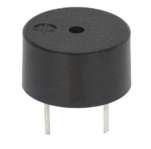Rtttl Buzzer
The rtttl, component allows you to easily connect a passive piezo buzzer to your microcontroller
and play monophonic songs. It accepts the Ring Tone Text Transfer Language, rtttl format
(Wikipedia) which allows to store simple melodies.

Overview Using a passive buzzer
It’s important that your buzzer is a passive one, if it beeps when you feed it with 3.3V then it is not a passive one and this library will not work properly.
The tone generator needs a PWM capable output to work with, currently only the ESP8266 Software PWM Output and ESP32 LEDC Output are supported.
# Example configuration entry
output:
- platform: ...
id: rtttl_out
...
rtttl:
output: rtttl_out
id: my_rtttl
gain: 60%Overview Using the I2S speaker
The tone generator can instead be used with a Speaker to output the audio.
# Example configuration entry
speaker:
- platform: ...
id: my_speaker
...
rtttl:
speaker: my_speaker
id: my_rtttl
gain: 0.8Configuration variables
output (Exclusive, ID): The id of the float output to use for this buzzer.
speaker (Exclusive, ID): The id of the speaker to play the song on.
id (Optional, ID): Manually specify the ID used for code generation.
gain (Optional, Percentage): With this value you can set the volume of the sound.
on_finished_playback (Optional, Automation): An action to be performed when playback is finished.
Note: You can only use the output or speaker variable, not both at the same time.
rtttl.play Action
Plays an rtttl tone.
on_...:
then:
- rtttl.play: 'siren:d=8,o=5,b=100:d,e,d,e,d,e,d,e'Configuration options:
- rtttl (Required, string, templatable): The rtttl string.
You can find many rtttl strings online on the web, they must start with a name, then a colon: : symbol
and more codes of the song itself. Tip: you can try playing with the values of d=16,o=6,b=95 and make the
song play at a different pace or pitch, e.g. setting o=7 instead will cause the song to play on a higher pitch.
rtttl.stop Action
Stops playback.
on_...:
then:
- rtttl.stopAll actions
- id (Optional, ID): Manually specify the ID of the rtttl if you have multiple components.
rtttl.is_playing Condition
This Condition returns true while playback is active.
# In some trigger:
on_...:
if:
condition:
rtttl.is_playing
then:
logger.log: 'Playback is active!'Common beeps
You can do your own beep patterns too! Here’s a short collection so you can just use right away or tweak them to your like:
two_short:d=4,o=5,b=100:16e6,16e6
long:d=1,o=5,b=100:e6
siren:d=8,o=5,b=100:d,e,d,e,d,e,d,e
scale_up:d=32,o=5,b=100:c,c#,d#,e,f#,g#,a#,b
star_wars:d=16,o=5,b=100:4e,4e,4e,8c,p,g,4e,8c,p,g,4e,4p,4b,4b,4b,8c6,p,g,4d#,8c,p,g,4e,8p
mission_imp:d=16,o=6,b=95:32d,32d#,32d,32d#,32d,32d#,32d,32d#,32d,32d,32d#,32e,32f,32f#,32g,g,8p,g,8p,a#,p,c7,p,g,8p,g,8p,f,p,f#,p,g,8p,g,8p,a#,p,c7,p,g,8p,g,8p,f,p,f#,p,a#,g,2d,32p,a#,g,2c#,32p,a#,g,2c,a#5,8c,2p,32p,a#5,g5,2f#,32p,a#5,g5,2f,32p,a#5,g5,2e,d#,8d
mario:d=4,o=5,b=100:16e6,16e6,32p,8e6,16c6,8e6,8g6,8p,8g,8p,8c6,16p,8g,16p,8e,16p,8a,8b,16a#,8a,16g.,16e6,16g6,8a6,16f6,8g6,8e6,16c6,16d6,8b,16p,8c6,16p,8g,16p,8e,16p,8a,8b,16a#,8a,16g.,16e6,16g6,8a6,16f6,8g6,8e6,16c6,16d6,8b,8p,16g6,16f#6,16f6,16d#6,16p,16e6,16p,16g#,16a,16c6,16p,16a,16c6,16d6,8p,16g6,16f#6,16f6,16d#6,16p,16e6,16p,16c7,16p,16c7,16c7,p,16g6,16f#6,16f6,16d#6,16p,16e6,16p,16g#,16a,16c6,16p,16a,16c6,16d6,8p,16d#6,8p,16d6,8p,16c6Test setup
With the following code you can quickly setup a node and use Home Assistant’s service in the developer tools.
E.g. for calling rtttl.play select the service esphome.test_esp8266_rtttl_play and in service data enter
song_str: 'scale_up:d=32,o=5,b=100:c,c#,d#,e,f#,g#,a#,b'Sample code
esphome:
name: test_esp8266
esp8266:
board: nodemcuv2
wifi:
ssid: !secret wifi_ssid
password: !secret wifi_password
output:
- platform: esp8266_pwm
pin: GPIOXX
id: rtttl_out
rtttl:
output: rtttl_out
on_finished_playback:
- logger.log: 'Song ended!'
api:
actions:
- action: rtttl_play
variables:
song_str: string
then:
- rtttl.play:
rtttl: !lambda 'return song_str;'
